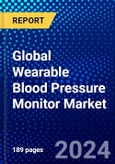The Global Wearable Blood Pressure Monitor Market is estimated to be USD 2.53 Bn in 2023 and is expected to reach USD 5.18 Bn by 2028 growing at a CAGR of 15.42%.
Technology advancement and the rising healthcare sector in emerging countries are expected to generate untapped opportunities for the market.
2. Aktiia Receives CE Mark Approval for Breakthrough 24-7 Blood Pressure Monitoring System. - 26th January 2021.
Market Dynamics
The increasing prevalence and demand for blood pressure monitoring are the major factors driving the wearable blood pressure monitor market. In addition, the rising geriatric population, unhealthy lifestyle leading to hypertension, and increasing smart healthcare device awareness are fuelling the market growth. The increase in the trend of home healthcare and self-use devices due to additional benefits such as tracking patients' health information, tracking physical activity, and monitoring sleep patterns is anticipated to grow the market. However, a lack of awareness among the emerging countries and lack of precision and compatibility issues with other devices hinder market growth.Technology advancement and the rising healthcare sector in emerging countries are expected to generate untapped opportunities for the market.
Market Segmentation
- The Global Wearable Blood Pressure Monitor Market is segmented further based on Product Type, Connectivity, Application, Measurement, Distribution Channel, and Geography.
- By Product Type, the market is classified into wrist blood pressure monitor, upper arm blood pressure monitor, and finger blood pressure monitor. Amongst all, the wrist blood pressure monitor segment is estimated to hold the highest market share during the forecast period.
- By Connectivity, the market is classified as WiFi and Bluetooth. Amongst the two, the Wifi segment is estimated to hold the highest market share during the forecast period.
- By Application, the market is classified as home healthcare, remote patient monitoring, sports & fitness, and others. Amongst all, the home healthcare segment is estimated to hold the highest market share during the forecast period.
- By Measurement, the market is classified as arterial tonometry, oscillometric method, and pulse transit time method. Amongst all, the arterial tonometry segment is estimated to hold the highest market share during the forecast period.
- By Distribution Channel, the market is classified as offline and online. Amongst the two, the offline segment is estimated to hold the highest market share during the forecast period.
- By Geography, North America is projected to lead the market.
Recent Developments
1. OMRON Healthcare Co. launched the very first 'all digital' VitalSight, patients receive a kit delivered to their home that includes an OMRON connected blood pressure monitor and data hub that are pre-set to securely share measurements with the patient's physician and care team. - 11th January 2021.2. Aktiia Receives CE Mark Approval for Breakthrough 24-7 Blood Pressure Monitoring System. - 26th January 2021.
Company Profiles
Some of the companies covered in this report GE Healthcare, ForaCare Suisse AG, Omron Corporation, Xiaomi Corporation, Koninklijke Philips N.V., Medaval Ltd, etc.Competitive Quadrant
The report includes Competitive Quadrant, a proprietary tool to analyze and evaluate the position of companies based on their Industry Position score and Market Performance score. The tool uses various factors for categorizing the players into four categories. Some of these factors considered for analysis are financial performance over the last 3 years, growth strategies, innovation score, new product launches, investments, growth in market share, etc.Why buy this report?
- The report offers a comprehensive evaluation of the Global Wearable Blood Pressure Monitor Market. The report includes in-depth qualitative analysis, verifiable data from authentic sources, and projections about market size. The projections are calculated using proven research methodologies.
- The report has been compiled through extensive primary and secondary research. The primary research is done through interviews, surveys, and observation of renowned personnel in the industry.
- The report includes an in-depth market analysis using Porter's 5 forces model and the Ansoff Matrix. In addition, the impact of Covid-19 on the market is also featured in the report.
- The report also includes the regulatory scenario in the industry, which will help you make a well-informed decision. The report discusses major regulatory bodies and major rules and regulations imposed on this sector across various geographies.
- The report also contains the competitive analysis using Positioning Quadrants, the Proprietary competitive positioning tool.
Report Highlights:
- A complete analysis of the market, including parent industry
- Important market dynamics and trends
- Market segmentation
- Historical, current, and projected size of the market based on value and volume
- Market shares and strategies of key players
- Recommendations to companies for strengthening their foothold in the market
Table of Contents
1 Report Description
2 Research Methodology
3 Executive Summary
4 Market Influencers
5 Market Analysis
6 Global Wearable Blood Pressure Monitor Market, By Product Type
7 Global Wearable Blood Pressure Monitor Market, By Connectivity
8 Global Wearable Blood Pressure Monitor Market, By Application
9 Global Wearable Blood Pressure Monitor Market, By Measurement
10 Global Wearable Blood Pressure Monitor Market, By Distribution Channel
11 Global Wearable Blood Pressure Monitor Market, By Geography
12 Competitive Landscape
13 Company Profiles
14 Appendix
Companies Mentioned
- Ambio Health, Inc.
- Apple Inc.
- BioTelemetry, Inc
- Blipcare
- CharmCare
- Fitbit, Inc.
- ForaCare Suisse AG
- Garmin Ltd
- GE Healthcare
- iHealth Lab Inc.
- Koninklijke Philips N.V.
- Koogeek Inc
- Medaval Ltd
- Medtronic plc
- Nokia Corporation
- Omron Corporation
- Qardio, Inc.
- Smiths Group plc
- Tarilian Laser Technologies
- Xiaomi Corporation




